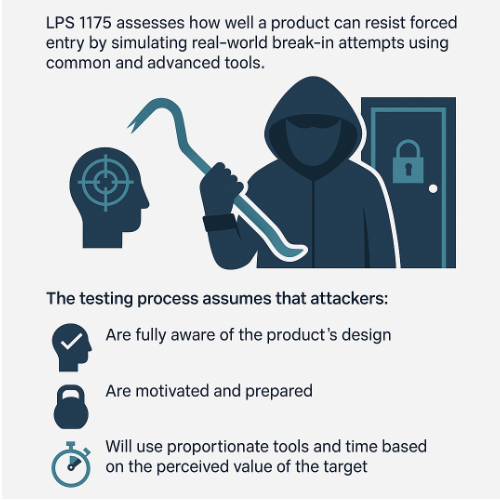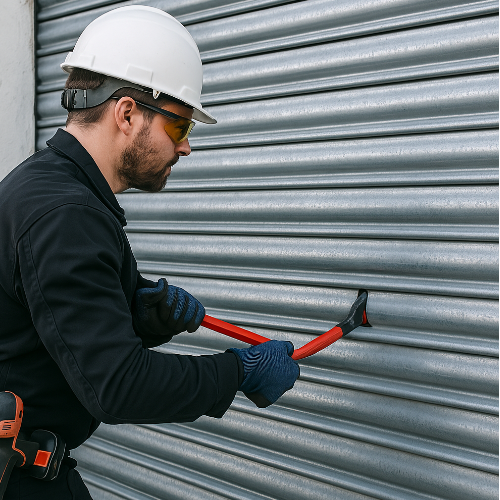If you’re researching high-security roller shutters or doors, you’ve likely come across the term LPS 1175. But what does it actually mean—and why should it matter to you?
This guide breaks down LPS 1175 in simple terms, including how the standard works, what the ratings mean, and how to choose the right level of protection for your property.
🔐 What Is LPS 1175?
LPS 1175 stands for Loss Prevention Standard 1175, a globally recognized benchmark for testing and certifying the intruder resistance of physical security products.
This includes:
-
Roller shutters
-
Doors
-
Fences
-
Grilles
-
Enclosures
-
Key safes
-
And more
The standard is published by the Loss Prevention Certification Board (LPCB), part of the UK’s Building Research Establishment (BRE)—a body trusted by insurers, governments, and security professionals alike.
🛠️ What Does LPS 1175 Test For?
LPS 1175 assesses how well a product can resist forced entry by simulating real-world break-in attempts using common and advanced tools. The testing process assumes that attackers:
-
Are fully aware of the product’s design
-
Are motivated and prepared
-
Will use proportionate tools and time based on the perceived value of the target

🧰 Security Ratings: How Are They Measured?
LPS 1175 uses a grading system that combines:
-
Tool Category (A to H) — representing the type and power of tools used
-
Delay Time (1 to 20 minutes) — representing how long the product can resist sustained attack
Each certified product receives a rating like B3 or D10, where the letter indicates the tool kit and the number shows the minimum delay time in minutes.
Example:
C5 = Tested with Tool Kit C and resists at least 5 minutes of continuous attack.
📊 Security Rating Categories (Quick Reference)
| Rating | Tools Used | Max Attack Time | Total Test Duration | Typical Applications |
|---|---|---|---|---|
| SR1 (A1) | Opportunist tools | 1 minute | 10 minutes | Schools, retail, offices |
| SR2 (B3) | Hand tools | 3 minutes | 15 minutes | Public spaces, communal areas |
| SR3 (C5) | Heavy hand tools | 5 minutes | 20 minutes | Warehouses, utility rooms |
| SR4 (D10) | Power tools | 10 minutes | 30 minutes | Banks, MOD sites, gun rooms |
| SR5–SR8 | Advanced power tools | 10–20 minutes | 30–60 minutes | Critical infrastructure, high-risk sites |
The higher the rating, the more sophisticated the tools and the longer the delay a product can withstand.
Check out this handy infographic from LPCB that breaks down each SR rating alongside the corresponding toolsets used in testing.
🔐 LPS 1175 Security Ratings: What They Mean (In Detail)
🛡️ SR1 – Basic Deterrent Against Opportunists
Risk Level: Low-risk domestic or commercial settings
Tools Used: Simple, easily carried hand tools (e.g. screwdrivers, small hammers)
Attack Time: Up to 1 minute
Test Window: 10 minutes total (including rest breaks)
Summary:
SR1-rated products are built to delay casual intruders relying mostly on brute force or unsophisticated tools. Ideal for places like communal entrances or general public-facing areas.
🛡️ SR2 – Protection from More Determined Opportunists
Risk Level: Medium-risk homes and light commercial sites
Tools Used: Wider range of hand tools, potentially creating more noise (e.g. pliers, crowbars)
Attack Time: Up to 3 minutes
Test Window: 15 minutes total
Summary:
SR2 increases resistance, suitable for applications where opportunistic attacks may involve more effort or stronger tools. Often used in retail units, offices, and low-risk utility spaces.
🛡️ SR3 – Resistance Against Determined Intrusion
Risk Level: Low to medium commercial risk
Tools Used: Heavier hand tools that offer mechanical advantage (e.g. claw hammers, drills, chisels)
Attack Time: Up to 5 minutes
Test Window: 20 minutes total
Summary:
SR3-rated products are designed to delay more determined criminals who are prepared to cause noise and take extra time. Commonly used in warehouses, server rooms, and utility cabinets.
🛡️ SR4 – Serious Protection Against Skilled Attackers
Risk Level: Medium commercial or public sector risk
Tools Used: A full suite of powerful tools including battery-powered devices (e.g. grinders, reciprocating saws)
Attack Time: Up to 10 minutes
Test Window: 30 minutes total
Summary:
This level provides robust defence against experienced attackers willing to use serious tools. Often specified for government sites, utility infrastructure, and secure storage facilities.
🛡️ SR5 – High-Risk and Mission-Critical Defence
Risk Level: High-value commercial or operationally critical areas
Tools Used: Advanced power tools with longer operational durations (e.g. demolition drills, heavy-duty grinders)
Attack Time: Up to 10 minutes
Test Window: 30 minutes total
Summary:
SR5 offers strong, prolonged resistance where high-value targets are involved. Appropriate for data centres, transport hubs, and high-security zones.
🛡️ SR6 – Resistance to Specialist Intrusion Methods
Risk Level: Professional-level threats
Tools Used: Highly specialized power tools, often used in commercial break-ins or targeted criminal efforts
Attack Time: 10 minutes
Test Window: 30 minutes
Summary:
SR6 products are tested against highly trained attackers using precision tools. Common in critical national infrastructure, telecoms, and sensitive storage environments.
🛡️ SR7 – Delayed Access to Secure Internal Assets
Risk Level: High-value or secondary internal areas after initial breach
Tools Used: Heavy, professional-grade tools designed for follow-up penetration
Attack Time: 10 minutes
Test Window: 30 minutes
Summary:
SR7 assumes the attacker has already passed an external barrier and is attempting to breach internal, highly secure areas. Used for vaults, secured server rooms, or high-value internal compartments.
🛡️ SR8 – Extreme Threat Protection
Risk Level: Maximum threat scenarios
Tools Used: A combination of powerful, often petrol-driven tools—just short of firearms or explosives
Attack Time: 20 minutes
Test Window: 60 minutes
Summary:
SR8 is built for maximum resilience, where products must withstand sustained, aggressive attacks from organised criminals. Common in defence, high-security laboratories, or critical data storage.
🧪 How Are Products Tested?
Products are subjected to rigorous attack simulations by professional testers. These tests include:
-
Manual attacks using pre-defined tool kits
-
Real-time simulations of intrusions
-
Multiple testers working in timed stages
-
Exploratory tests to find weak points
If the product resists the attack within the specified limits—and if the manufacturer has robust quality control in place—it earns LPS 1175 certification.

📝 Who Certifies It?
Certification is managed by LPCB, which ensures products meet the high standards of LPS 1175. To stay certified, manufacturers must pass regular audits and maintain strict quality controls.
Certified products are listed on RedBook Live, the official online directory used by specifiers, architects, and security professionals.
🔍 LPS 1175 vs EN 1627: What’s the Difference?
EN 1627 is a European standard that, like LPS 1175, assesses the resistance of building components to forced entry. But there are some important differences—especially in how they simulate real-world break-ins.
EN 1627 Focuses on Stealth Attacks
EN 1627 is primarily designed to replicate opportunistic, low-noise break-ins—the kind a burglar might attempt at night without drawing attention.
These attacks avoid loud tools and breaking glass, focusing instead on:
-
Prying open windows
-
Quietly manipulating locks
-
Forcing entry with basic hand tools
This is what we mean by “stealth-based attacks.”
Understanding the RC1 to RC3 Ratings
EN 1627 uses Resistance Class (RC) ratings to define security levels.
| Rating | Threat Type | Tools Simulated | Attack Style |
|---|---|---|---|
| RC1 | Very low risk | No tools—only physical force (e.g. kicking, shoulder barges) | Very basic intruder |
| RC2 | Low risk | Basic hand tools like screwdrivers, pliers | Quiet forced entry |
| RC3 | Moderate risk | Heavier hand tools, such as crowbars | Determined but stealthy attacker |
RC1 to RC3 are designed for residential settings or low-risk commercial premises, where intruders want to remain unnoticed and avoid setting off alarms or alerting neighbors.
Why LPS 1175 Is More Robust
LPS 1175, by contrast, is built to test how well a product stands up to determined attackers who may:
-
Use power tools like grinders or drills
-
Spend several minutes trying to break through
-
Ignore noise levels
This makes LPS 1175 a better fit for higher-risk environments like banks, utility buildings, warehouses, or critical infrastructure.
In summary:
-
EN 1627 = Stealthy, quick, low-impact attacks
-
LPS 1175 = Determined, noisy, and extended attacks
🤔 Other Related Standards
🔸 PAS 24
A UK standard focused on residential door and window security.
-
It’s a pass/fail test (no rating levels)
-
Doesn’t allow glass breakage
-
Limited to stealth attacks, not prolonged force
LPS 1175 covers a wider range of products and threats.
🧠 How to Choose the Right Security Rating
Consider the following questions:
- What are you protecting? (People, assets, property)
- What is the threat level? (Opportunist thieves vs. professional criminals)
- Where is your building located? (Urban, remote, high-crime area)
- What is the likely frequency and severity of attack?
- Are there layered security measures in place?
For example:
-
A retail store may only need SR2
-
A data centre might require SR4 or higher
-
National infrastructure sites may need SR6–SR8
🚨 What LPS 1175 Doesn’t Cover
While LPS 1175 is highly comprehensive, it doesn’t test resistance to:
-
Ballistics
-
Explosions
-
Fire
-
Chemical attack
-
Electrical manipulation
-
Tunneling or scaling for freestanding barriers
Additional standards exist for those needs, such as:
-
LPS 1270 – Security glazing
-
LPS 1242 – Lock cylinders
-
LPS 1654 – Padlocks
🏢 Why It Matters for Roller Shutters
Choosing LPS 1175-rated roller shutters means your property is protected by a product that has been independently tested under real-world conditions.
At UK Roller Shutters, our LPS 1175-certified roller shutters come in a range of ratings—from SR2 for retail to SR4+ for high-security environments—giving you peace of mind and compliance with industry standards.
✅ Key Benefits of LPS 1175-Certified Roller Shutters
-
✅ Independently tested and verified
-
✅ Resistance to real-world attack scenarios
-
✅ Insurance-approved
-
✅ Meets government and infrastructure standards
-
✅ Ideal for high-risk commercial and public sector sites
🔚 Final Thoughts on LPS 1175
Understanding LPS 1175 is essential when choosing physical security products that offer genuine, tested protection. Unlike generic claims of being “strong” or “secure,” LPS 1175 provides a measurable, third-party verified benchmark that reflects how a product performs against real-world break-in attempts.
Whether you’re protecting a retail unit, warehouse, or high-risk facility, selecting the right Security Rating (SR) helps ensure your roller shutters—and any other barriers—offer the level of resistance appropriate for your threat profile.
At UK Roller Shutters, all of our LPS 1175-certified products are tested to meet these rigorous standards, giving you confidence that you’re investing in security solutions that are built to perform.
If you’re unsure which rating is right for you, or want help choosing the best shutter for your needs, our team is here to help.
📞 Call us: +44 (0) 1384 221743
📧 Email: sales@ukrollershutters.com
🌐 Visit: ukrollershutters.com
Secure what matters—properly, reliably, and with confidence.
